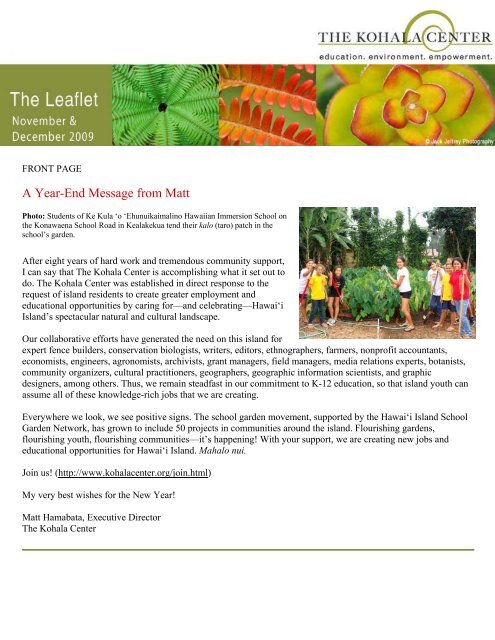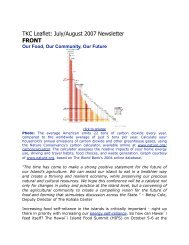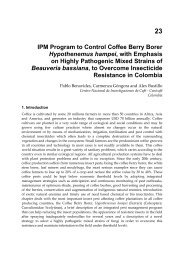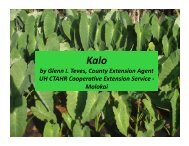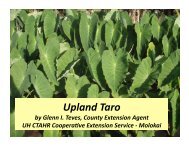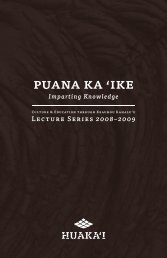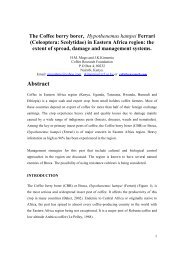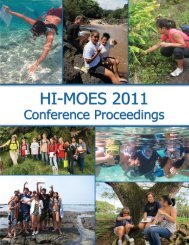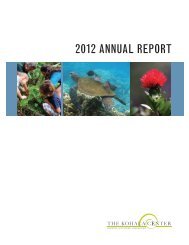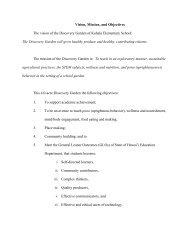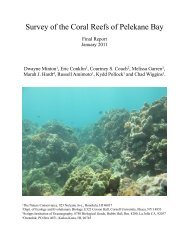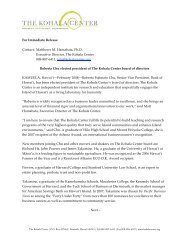A Year-End Message from Matt - The Kohala Center
A Year-End Message from Matt - The Kohala Center
A Year-End Message from Matt - The Kohala Center
Create successful ePaper yourself
Turn your PDF publications into a flip-book with our unique Google optimized e-Paper software.
FRONT PAGE<br />
A <strong>Year</strong>-<strong>End</strong> <strong>Message</strong> <strong>from</strong> <strong>Matt</strong><br />
Photo: Students of Ke Kula ‘o ‘Ehunuikaimalino Hawaiian Immersion School on<br />
the Konawaena School Road in Kealakekua tend their kalo (taro) patch in the<br />
school’s garden.<br />
After eight years of hard work and tremendous community support,<br />
I can say that <strong>The</strong> <strong>Kohala</strong> <strong>Center</strong> is accomplishing what it set out to<br />
do. <strong>The</strong> <strong>Kohala</strong> <strong>Center</strong> was established in direct response to the<br />
request of island residents to create greater employment and<br />
educational opportunities by caring for—and celebrating—Hawai‘i<br />
Island’s spectacular natural and cultural landscape.<br />
Our collaborative efforts have generated the need on this island for<br />
expert fence builders, conservation biologists, writers, editors, ethnographers, farmers, nonprofit accountants,<br />
economists, engineers, agronomists, archivists, grant managers, field managers, media relations experts, botanists,<br />
community organizers, cultural practitioners, geographers, geographic information scientists, and graphic<br />
designers, among others. Thus, we remain steadfast in our commitment to K-12 education, so that island youth can<br />
assume all of these knowledge-rich jobs that we are creating.<br />
Everywhere we look, we see positive signs. <strong>The</strong> school garden movement, supported by the Hawai‘i Island School<br />
Garden Network, has grown to include 50 projects in communities around the island. Flourishing gardens,<br />
flourishing youth, flourishing communities—it’s happening! With your support, we are creating new jobs and<br />
educational opportunities for Hawai‘i Island. Mahalo nui.<br />
Join us! (http://www.kohalacenter.org/join.html)<br />
My very best wishes for the New <strong>Year</strong>!<br />
<strong>Matt</strong> Hamabata, Executive Director<br />
<strong>The</strong> <strong>Kohala</strong> <strong>Center</strong>
<strong>The</strong> Next Generation of Architects<br />
Photo: Four pieces of the land are explored as potential sites<br />
for the project, and the group eventually decides on the base<br />
of this hill for the natural protection it provides against ocean<br />
winds. From left to right: Jay Tapia, Erik Collins, Ryan<br />
Doone, Yuliya Bentcheva, Dashell Kuhr (TKC), Professor<br />
Jan Wampler, and Kamana Beamer (TKC & UH). Photo by<br />
Amanda Levesque.<br />
For the past 15 years, Jan Wampler, Distinguished<br />
Professor of Architecture at the Massachusetts<br />
Institute of Technology (MIT), has been taking small<br />
groups of students beyond the walls of their Cambridge studios to expose them to new cultures, new materials, and real<br />
world problems. Wampler believes that our next generation of architects should be prepared to work in a global<br />
context—designing affordable structures <strong>from</strong> locally available materials to meet local needs. Over the years, Wampler<br />
has taught architecture workshops in places like Cuba, Ecuador, Haiti, Mexico, Turkey, and Pakistan.<br />
Seeking to fill a local need for affordable farm housing for young farmers in North <strong>Kohala</strong>, <strong>The</strong> <strong>Kohala</strong> <strong>Center</strong> sent out a<br />
call for designs that will allow farm families to move onto land as quickly as possible with the potential of expanding<br />
their living space as their families grow and their farm operations prosper. When an MIT representative visiting Hawai‘i<br />
heard about this design challenge, he contacted Professor Wampler, who initiated a dialogue with <strong>The</strong> <strong>Kohala</strong> <strong>Center</strong><br />
this past summer. Wampler explained that he has three criteria by which he evaluates potential projects: (1) they must<br />
have a good chance of being built; (2) they must have a nonprofit partner as well as the commitment of the landowner to<br />
see the project through; and (3) they must have support <strong>from</strong> local architects and planners to ensure that permits are<br />
obtained in a timely fashion to enable completion of the project. <strong>The</strong> <strong>Kohala</strong> <strong>Center</strong>’s affordable farm dwelling project<br />
in North <strong>Kohala</strong> meets all three criteria, and Wampler agreed to bring a group of students to the site in late October to<br />
meet the landowner and gather background information in order to prepare farm dwelling designs.<br />
Wampler selected a mix of 6 undergraduate and graduate students <strong>from</strong> a pool of 40 applicants to participate in this<br />
project; on October 24-27, the MIT group visited the project site to survey the property, meet with the young farmers<br />
who will occupy the affordable farm dwellings, absorb as much historical and cultural background as possible, and meet<br />
with local planners, builders, and suppliers to consider materials and designs. <strong>The</strong> MIT group spent their first evening<br />
with Dr. Kamana Beamer, assistant professor in the Hawaiian Studies Department at UH Mānoa and Mellon-Hawai‘i<br />
Fellow; Dr. Ka‘eo Duarte <strong>from</strong> Kamehameha Schools Land Asset Division; and Dr. Guy Kaulukukui <strong>from</strong> <strong>The</strong> <strong>Kohala</strong><br />
<strong>Center</strong>, who addressed the students at an opening dinner. <strong>The</strong> next day the MIT group continued their orientation to the<br />
cultural and natural landscape of Hawai‘i Island under the direction of Professor Beamer. <strong>The</strong> following day the MIT<br />
team met with Pat Batchelder <strong>from</strong> HPM; Brad Kurokawa, a principal of Ki Concepts LLC and a former Hawai‘i<br />
County Deputy Planning Director; and Michael Gornik, a local contractor who generously provided information about<br />
current Hawai‘i building trends and materials. Dash Kuhr and other young farmers <strong>from</strong> North <strong>Kohala</strong> also shared their<br />
reflections about their hopes and challenges as family farmers in Hawai‘i. This exchange of ideas is of mutual benefit<br />
with architects <strong>from</strong> abroad gaining knowledge <strong>from</strong> island experts and <strong>from</strong> island conditions, and in return, island<br />
communities tapping into the latest technologies and designs <strong>from</strong> the international architectural community.<br />
Wampler was struck by the beauty of this island, and he feels the project is progressing well. He and his students will<br />
return in January to unveil a model structure to the landowner, to present their ideas for how to situate the dwellings on<br />
the property, and to lay out the details of their overall plan for the site, including recommendations for incorporating<br />
conservation, agricultural, residential, communal, and infrastructural uses on the site. Learn more about the MIT<br />
Architecture Workshop in “Designing Affordable Farm Dwellings” on the back page.
Ma Ka Hana Ka ‘Ike (In Working, One Learns)<br />
Photo: Nancy Redfeather shared inspiring words and photos of the school garden<br />
movement with luncheon guests.<br />
On October 16, 2009, guests boarded the Golden Princess cruise ship in<br />
Hilo Harbor for the Seeds of Hope luncheon sponsored by Princess<br />
Cruise Lines. Guests received royal treatment <strong>from</strong> cruise staff<br />
including refreshments, a three-course sit-down lunch, and a tour of the<br />
recently refurbished cruise ship. Friends <strong>from</strong> around the island came<br />
together to celebrate the Hawai‘i Island School Garden Network’s<br />
(HISGN) commitment to island youth, to the future of island<br />
agriculture, and to promoting food self-reliance. Distinguished speakers<br />
included Mayor Billy Kenoi, State Senators Russell Kokubun and Dwight Takamine, and award-winning island<br />
filmmaker Danny Miller. Luncheon guests were treated to a sneak preview of Miller’s recently completed Seeds of Hope<br />
documentary, a look at agriculture in Hawai‘i, including the growing school garden movement. Seeds of Hope is<br />
targeted for release on Hawai‘i and national public television next spring.<br />
As we look at the state of agriculture in Hawai‘i, the one thing that stands out are the large number of real heroes—<br />
individuals who are doing amazing work, including Nancy Redfeather and a lot of the other folks here today. <strong>The</strong>y are<br />
really making a difference, and that is why we entitled the film Seeds of Hope. <strong>The</strong>re are incredible people doing<br />
incredible things across the state, and we hope this film will inspire others to do more work like you folks are doing.<br />
–filmmaker Danny Miller<br />
Photo: Everyone departed with packets of seeds to plant: vegetables, flowers,<br />
herbs, and hope for the future. Seeds were donated by Toni Reynolds, a teacher at<br />
Kealakehe Elementary School.<br />
As a kid, I liked to play in the dirt. My grandmother always had a<br />
garden at our home. <strong>The</strong> lessons that she taught me had not only to do<br />
with how to grow things but the entire relationship that you have as an<br />
individual to the Earth, to all natural resources—the awe and wonder<br />
that is generated when you work with the soil and when you work in the<br />
gardens. <strong>The</strong> potential of the school garden program is huge—it starts<br />
with our young people, it starts with the commitment that all of you<br />
have made to teaching our young people how to value our environment.<br />
–Senator Russell Kokubun<br />
<strong>The</strong> <strong>Kohala</strong> <strong>Center</strong> extends a warm mahalo (thank you) to our senators and Mayor Kenoi for their support of<br />
agricultural education and to Danny Miller, who inspired us to create this luncheon to celebrate the work of the school<br />
garden teachers across the island.
In Celebration of Life<br />
Photo: Herb Kane (left) and his wife Deon Kane (center) with Hawai‘i County<br />
Mayor Billy Kenoi (right) at the 2009 Bay Concert. Herb Kane is holding a<br />
proclamation honoring his lifetime achievements which Mayor Kenoi presented to<br />
him at the start of the concert. Photo by Randy Magnus.<br />
I thoroughly enjoyed attending this year’s Bay Concert in honor of<br />
the great Herb Kane. <strong>The</strong> Daifukuji Taiko Drummers were simply<br />
awesome. <strong>The</strong> music of Na Leo Pilimehana and Ho‘okena lifted my<br />
heart and reminded me how lucky I am to live in this wonderful<br />
place. Frank De Lima was a great host and added just the right<br />
amount of lightness and humor to the event. Congratulations to you<br />
and all of the hard working volunteers on a wonderful event!<br />
–Senator Gary L. Hooser, Majority Leader, Hawai‘i State Senate<br />
A full house gathered in the Convention <strong>Center</strong> at the Sheraton Keauhou Resort for the third annual Bay Concert on<br />
November 21. Over 900 people came out to enjoy the music and Frank De Lima’s island style humor, and to celebrate<br />
the rebirth of Kahalu‘u Bay. <strong>The</strong> <strong>Kohala</strong> <strong>Center</strong> extends a gracious mahalo to each and every one of you. This year’s<br />
concert paid tribute to Herb Kane, Hawaiian artist, historian, voyager, and living treasure. Mayor Billy Kenoi honored<br />
Kane’s achievements as a world renowned artist and community leader by proclaiming November 21, 2009, as Herbert<br />
Kawainui Kane Day.<br />
<strong>The</strong> <strong>Kohala</strong> <strong>Center</strong> believes in the importance of community in all that they do and the Bay Concert affirms their<br />
commitment to using their educational presence in the community as a community-building opportunity. It was a<br />
great evening celebrating a great cause. –Dr. Gregory Chun, Kamehameha Schools Kahalu‘u Keauhou Educational<br />
Group<br />
Photo: <strong>The</strong> musicians of Ho‘okena at the 2009 Bay Concert. Photo by Randy<br />
Magnus.<br />
It was a great concert and such a fun evening with so many friends of <strong>The</strong><br />
<strong>Kohala</strong> <strong>Center</strong> and friends of the environment. Thank you for the good time<br />
we all had, and the music was awesome! –Marni Herkes, <strong>Kohala</strong> <strong>Center</strong><br />
board member<br />
Over 360 community volunteers and three dozen island businesses<br />
actively volunteer their time as ReefTeachers in the community and at<br />
Kahalu‘u Bay, to educate visitors on how to engage with the fragile<br />
coral reef environment without damaging it. Many of these<br />
ReefTeachers joined in the festivities at the concert, clad in their blue<br />
ReefTeach T-shirts. <strong>The</strong> ReefTeach program reaches an average of 85<br />
visitors per day and 1,200 K-12 students annually. <strong>The</strong> Bay Concert helps to sustain the ReefTeach Program and <strong>The</strong><br />
<strong>Kohala</strong> <strong>Center</strong>’s efforts to restore the historic, cultural, and natural resources of Kahalu‘u Bay. <strong>The</strong> dollars raised will<br />
help to support the Kahalu‘u Bay Project well into the coming year.<br />
From my childhood I fondly remember Kahalu‘u Beach and Bay as a special place of beauty and bounty. <strong>The</strong> beach<br />
and reef thrived and were teeming with fish, as were most of the bays along the Kona Coast. I have a deep, heartfelt<br />
connection to Kahalu‘u Bay, and I am truly grateful for the opportunity to give back to my beloved home through my<br />
work with <strong>The</strong> <strong>Kohala</strong> <strong>Center</strong>. Our programs are nurturing a deeper awareness and appreciation for our connection<br />
with the ‘āina [land], as we celebrate the cultural, environmental, and social significance of Kahalu‘u, its beauty, and<br />
its ability to sustain life. –Cindi Punihaole, Outreach and Volunteer Coordinator for <strong>The</strong> <strong>Kohala</strong> <strong>Center</strong>
Brown Environmental Leadership Lab Welcomes Island Students<br />
Photo: Maryam Palma, 2009 BELL-Hawai‘i scholarship recipient weaving a lei with the<br />
palapalai fern<br />
Island high school students are invited to participate in Brown University’s<br />
Environmental Leadership Lab on Hawai‘i Island <strong>from</strong> April 2–9, 2010. <strong>The</strong><br />
BELL-Hawai‘i Program brings together 30 outstanding young leaders <strong>from</strong> across<br />
the country and around the globe to study in the world’s most vibrant living<br />
classroom—Hawai‘i Island. Students will explore Hawai‘i Volcanoes National<br />
Park and learn about the active geology of Hawai‘i. <strong>The</strong>y will kayak in Kealakekua<br />
Bay and learn about the marine ecology and coral reefs of Hawai‘i at Ke‘ei. <strong>The</strong>y<br />
will engage in leadership activities with some of the finest environmental educators<br />
in the nation, and they will give back to our community through service work in<br />
Ka‘ūpūlehu Dry Forest. Island experts will introduce the students to native plants<br />
and marine life and explain how to mālama (care for) the land and the ocean. <strong>The</strong>y<br />
will also share the cultural traditions and deep connection of the Hawaiian people<br />
with this land. Visit the BELL Web site (http://www.brown.edu/ce/precollege/leadership/hawaii/)<br />
for more program details.<br />
Here’s how last year’s participants rated their BELL-Hawai‘i experience:<br />
“I learned a lot about the history and culture of Hawai‘i and how it pertains to the environment, and was able to<br />
observe the connections.”<br />
“Not only were all of my expectations surpassed, but the program sparked an interest in geology.”<br />
“I made 29 new friends (yay!), and we saw dryland forest and many other climates and ecosystems. I learned a lot about<br />
Hawaiian culture, both modern and traditional, as well as a ton about geology. I particularly enjoyed talking story with<br />
the kūpuna (Hawaiian elders) because they were immediately welcoming and I learned a bunch <strong>from</strong> them. I also really<br />
loved kayaking, snorkeling, and learning about the reefs that were right in front of our eyes.”<br />
<strong>The</strong> <strong>Kohala</strong> <strong>Center</strong> and Brown University are offering full scholarships to the BELL Hawai‘i Program for two<br />
Hawai‘i Island students. <strong>The</strong> scholarship application deadline is Friday, January 29, 2010. To apply, visit<br />
http://www.kohalacenter.org/bell.html.<br />
Indigenous Ways of Being<br />
Photo: Dr. Karin Ingersoll on a canoe that her husband, Russell Amimoto, built.<br />
In 2008, through the generosity of <strong>The</strong> Andrew W. Mellon<br />
Foundation and Kamehameha Schools, the Mellon-Hawai‘i<br />
Doctoral and Postdoctoral Fellowship Program was established at<br />
<strong>The</strong> <strong>Kohala</strong> <strong>Center</strong>. This program provides fellowships to Native<br />
Hawaiian scholars whose research is about Hawai‘i’s natural and<br />
cultural landscapes or about Hawai‘i’s history, politics, or society.<br />
<strong>The</strong> Mellon-Hawai‘i Fellowship recognizes Hawai‘i’s leading<br />
thinkers and writers, many of whom are at the start of their scholarly<br />
careers. In this issue we are pleased to feature the work of Postdoctoral<br />
Fellow Karin Na‘auali‘i Amimoto Ingersoll, who earned a Ph.D in political science <strong>from</strong> the Department of Political<br />
Science at the University of Hawai‘i at Mānoa.
My scholarly and professional interests and goals revolve around one mission, to (re)immerse Native Hawaiian youth<br />
into the ocean: to smell it, taste it, touch it, hear it, and experience it as a fundamental component of learning. <strong>The</strong><br />
aim is to privilege our indigenous ways of learning, knowing and being in the world to reaffirm our native identities<br />
and to encourage aloha ‘āina (land stewardship). In my dissertation, I explored the idea of building a hālau o ke kai<br />
(ocean-based cultural center) to apply my concept of seascape epistemology, and although I have worked and<br />
informally talked with other community members, groups, and charter schools already engaged in similar projects, I<br />
have not yet had the opportunity to establish formal partnerships toward the realization of such a hālau. <strong>The</strong><br />
establishment of such working relationships is one of my main goals during this fellowship. –Karin Na‘auali‘i<br />
Amimoto Ingersoll, 2009 Mellon-Hawai‘i Postdoctoral Fellow<br />
Read Karin’s story “Anchored Within the Ocean” on the back page.<br />
Voices that Need to Be Heard<br />
Photo: 2009–2010 Mellon-Hawai‘i Fellows pose together after the kīhei ceremony on<br />
November 14. From left to right: Dr. Karin Ingersoll, Dr. Ku‘ualoha Ho‘omanawanui,<br />
Ms. Kauanoe Kamanā.<br />
Thanks to a generous gift of $125,000 <strong>from</strong> the Kahiau<br />
Foundation, the Mellon-Hawai‘i Fellowship Program will be<br />
expanded in the 2010–2011 academic year to support a total of<br />
five doctoral and postdoctoral fellows—two more fellows than in<br />
the current academic year. <strong>The</strong> Kahiau Foundation joins with <strong>The</strong><br />
Andrew W. Mellon Foundation, Kamehameha Schools, and <strong>The</strong><br />
<strong>Kohala</strong> <strong>Center</strong> in supporting the Mellon-Hawai‘i Fellowship<br />
program for Native Hawaiian scholars.<br />
This generation of young Hawaiian scholars is remarkable. <strong>The</strong>y are<br />
rigorously trained in both Western and Hawaiian research and interpretive traditions. <strong>The</strong>y are courageous in<br />
seeking the truth. Hawaiian history voiced by native scholars offers perspectives that need to be heard. –Allene<br />
Wong, a Kamehameha Schools graduate and co-founder of the Kahiau Foundation, along with her husband David<br />
Eckles<br />
Through the Fellowship Program, doctoral fellows are given the opportunity to complete their dissertations before<br />
accepting their first academic posts. Postdoctoral fellows are given the opportunity to publish original research<br />
early in their academic careers. Doctoral fellows are awarded $40,000 for the academic year, and postdoctoral<br />
fellows are awarded $50,000. Application materials for the academic year 2010–2011 are now available at<br />
http://kohalacenter.org/mellon/app.html. Completed applications must be received by February 15, 2010.
Hala No Ia Lā O Ka Pōloli: A Hungry Day Passes<br />
Photo: Kalo image courtesy of Nā Maka Hāloa.<br />
This Hawaiian phrase is an expression of thankfulness that there was<br />
food for another day. Kalo, a staple of the traditional Hawaiian diet,<br />
has deep cultural significance in the Hawaiian culture, and there are<br />
passionate issues revolving around kalo and the introduction of<br />
genetically modified organisms (GMO). <strong>The</strong> public is invited to a<br />
free panel discussion to learn more about these issues. <strong>The</strong> November<br />
Puana Ka ‘Ike (imparting knowledge) lecture series will feature three<br />
expert panelists offering their perspectives on these issues, in order to<br />
deepen public awareness as community discussions about kalo and GMO continue.<br />
Dr. Dennis Gonsalves, director of the Pacific Basin Agricultural Research <strong>Center</strong>; Jerry Konanui, president of the<br />
Association for Hawaiian Awa; and Dr. William Steiner, dean of the College of Agriculture, University of Hawai‘i at<br />
Hilo, will speak in Hilo <strong>from</strong> noon to 1:30 p.m. on Monday, November 30, at the UH Hilo in the University<br />
Classroom Building 127. Gonsalves, a native of <strong>Kohala</strong>, is a plant virologist by training and led the research team that<br />
developed the virus resistant genetically engineered papaya in Hawai‘i. Konanui, a member of the Hawai‘i State Taro<br />
Task Force representing the statewide Onipa‘a Na Hui Kalo organization, has presented educational workshops and<br />
demonstrations on awa (kava); and taro research in Hawai‘i and the South Pacific. Steiner has served as Dean for the<br />
University of Hawai‘i at Hilo College of Agriculture, Forestry, and Natural Resource Management since 2005,<br />
researching biofuel development, heritage foods development, and dairy and equine sciences.<br />
<strong>The</strong> Puana Ka ‘Ike Lecture Series is made possible by a partnership between Kamehameha Investment<br />
Corporation/Kamehameha Schools, <strong>The</strong> <strong>Kohala</strong> <strong>Center</strong>, Kīpuka Native Hawaiian Student <strong>Center</strong> at the University of<br />
Hawai‘i at Hilo, and Keauhou Beach Resort. For more information on the kalo panel presentation, contact Natalie<br />
Deisroth at 808-322-0088, ext. 100, or e-mail info@kohalacenter.org. For a schedule of upcoming lectures or more<br />
information about previous lectures, visit http://kohalacenter.org/puanakaike/about.html.<br />
A Gift to Our Members<br />
Image: Cover of the August 2009 Hawai‘i Business magazine.<br />
<strong>The</strong> <strong>Kohala</strong> <strong>Center</strong> is continually expanding its network of partnerships that add<br />
value to membership in our Circle of Friends. This month, we are pleased to<br />
invite our members to sign up to receive a free one-year subscription to Hawai‘i<br />
Business magazine, a $56.00 gift based on the annual newsstand price.<br />
Hawai‘i Business magazine supports the statewide business community by<br />
delivering useful and insightful stories on everything <strong>from</strong> big issues and big<br />
business to entrepreneurship and SmallBiz. We believe in <strong>The</strong> <strong>Kohala</strong> <strong>Center</strong>’s<br />
mission and invite you to become not only a regular reader, but to contribute<br />
feedback, comments, and story ideas to our editorial team through the e-mail<br />
address feedback@hawaiibusiness.com. –Patrick Parsons, Director of Marketing,<br />
Hawai‘i Business Magazine<br />
Sign up for a complimentary subscription to Hawai‘i Business magazine at<br />
http://www.hawaiibusiness.com/Hawaii-Business/<strong>Kohala</strong>-<strong>Center</strong>-Subscription/.
BACK PAGE<br />
Designing Affordable Farm Dwellings<br />
Photos by Amanda Levesque<br />
Photo: An on-site collaboration between MIT, the project's sponsors, and<br />
local farmers and experts leads to a productive exchange of ideas to inform<br />
the design. From left to right: Jay Tapia, Kamana Beamer (TKC & UH),<br />
Yuliya Bentcheva, Dash Kuhr (TKC), Ryan Doone, Erik Collins (Starseed<br />
Ranch), Professor Jan Wampler, Jyoti Ulrych (Starseed Ranch), Laua‘e<br />
Beamer (TKC), and <strong>The</strong>o Issaias.<br />
MIT graduate students Yuliya Bentcheva, Ryan Doone,<br />
<strong>The</strong>odossis Issaias, and Jay Tapia, and MIT undergraduate<br />
students Fred Kim and Amanda Levesque have done their homework. Preparations for this project began in<br />
September, when Professor Jan Wampler selected them to participate in this highly competitive workshop. Students<br />
lined up for the opportunity to work closely with Professor Wampler to learn how to design and build a project for<br />
a real client: in this case, Starseed Ranch owners Andre and Jyoti Ulrych. Students spent two months researching<br />
Hawai‘i Island’s history, cultural landscape, economy, and society, as well as the island’s paniolo and plantation<br />
architectural heritage and the availability and cost of local building materials. <strong>The</strong>ir assignment is to design<br />
affordable farm dwellings to house up to ten farming families on the land they will farm—a 100-acre parcel in<br />
North <strong>Kohala</strong>. Hawai‘i Island land costs prohibit many young families <strong>from</strong> farming since they cannot afford to<br />
buy or lease farm land or homes near to the land they are working. Jyoti Ulrych is keenly aware of the difficulties<br />
facing young farmers in North <strong>Kohala</strong>, and she is considering how to commit this 100-acre parcel to help solve<br />
these challenges.<br />
Photo: After a productive day on the site, the morale is high and Professor<br />
Wampler prepares to bring what the design team has learned <strong>from</strong> its hosts back<br />
to MIT. From left to right: Laua‘e Beamer, Kamana Beamer, Jyoti Ulrych, Jan<br />
Wampler, and Erik Collins.<br />
Very early on, the design team decided to cluster the farm<br />
dwellings in one location on the property so as to minimize<br />
infrastructure costs by utilizing a common roadway and utilities.<br />
<strong>The</strong> proposed dwellings will utilize solar energy and composting<br />
toilets and will be self-sustaining to the maximum extent possible.<br />
<strong>The</strong>y will also utilize materials that are or could be locally<br />
available, such as bamboo, to keep building costs to a minimum and to provide viable designs and markets for these<br />
materials. <strong>The</strong> design team is hoping to complete four work products by January, when they will return to the island<br />
to meet with the landowner. <strong>The</strong>se are: (1) a model structure testing bamboo and local materials; (2) an expanding<br />
house design with a few options for the owner to select amongst; (3) a layout for a cluster of such dwellings,<br />
including communal elements such as a day care center; and (4) an overall plan for the 100-acre site, including<br />
recommendations for which areas should be farmed, conserved, and developed for housing or roads. Professor<br />
Wampler is confident that the designs presented will be affordable and buildable at the site once the landowner<br />
obtains the necessary permits <strong>from</strong> the County. “If the landowner is on board, our work goes relatively quickly, and<br />
typically, our projects do get built,” says Wampler.<br />
<strong>The</strong> MIT students are eager to apply their skills to help island residents. Here’s what they said about this project:<br />
My interest in the project stems <strong>from</strong> a desire to provide affordable housing for a segment of the population that does<br />
not often benefit <strong>from</strong> the skills of design professionals. And yet, it is within this practice area that architects have the<br />
greatest potential to achieve a meaningful impact on people's lives. –Jay Tapia
Visiting the site, talking to local residents, learning about the culture and history of Hawai‘i, was an incredibly eyeopening<br />
experience to work on a real project that helps the community in Hawai‘i. –Fred Kim<br />
This experience has really driven home how great architecture revolves around the people who engage it and the land<br />
it extends <strong>from</strong>. I've never seen a place in which the people and the land are so intertwined as they are in Hawai‘i, so<br />
I know that this project has huge potential for success. –Amanda Levesque<br />
Photo: Professor Wampler and graduate student Yuliya Bentcheva listen to<br />
Dash's experience as a local farmer on acreage with similar site conditions.<br />
From left to right: Jan Wampler, Yuliya Bentcheva, Dash Kuhr, and Kamana<br />
Beamer.<br />
This workshop is providing us with the opportunity to learn a great<br />
deal about Hawai‘i's culture and people, and to use this knowledge<br />
in order to address the current issues of housing. As a team, we are<br />
designing a dwelling that takes into consideration the importance of<br />
the land and nature. We are using local materials and designing<br />
self-sustaining systems that will work with natural resources. This<br />
workshop allows us to be a part of a project that will be realized in<br />
the near future and will hopefully make a difference in the community.<br />
–Yuliya Bentcheva<br />
What is the architect’s proper cultural role in the international debate on global warming and sustainability? If<br />
architecture is a social art, how can its objectives can be achieved? Questions like these are directly answered<br />
through this workshop. From the whole ideological spectrum of the architectural field we suggest a more cohesive<br />
and inclusive practice, where architects and future inhabitants are working together with respect to nature and the<br />
land, and the local characteristics and patterns of living. <strong>The</strong> Hawai‘i workshop has been so far one of the most<br />
valuable and didactic experiences I ever had, not only architectonically but also personally. –<strong>The</strong>odossis Issaias<br />
<strong>The</strong> <strong>Kohala</strong> <strong>Center</strong> extends a warm mahalo to Professor Wampler and his MIT design team, and we look forward to<br />
welcoming them back to our shores in January.<br />
Eight Days of Non-Stop Enthusiasm<br />
Comments <strong>from</strong> 2009 BELL-Hawai‘i Scholarship Recipients<br />
Photo: Elai Dankner (right), 2009 BELL-Hawai‘i scholarship recipient, and David Cadaos<br />
(left), an intern working in the forest, pull fountain grass as part of their service work at<br />
Ka‘ūpūlehu Dry Forest.<br />
<strong>The</strong> Brown University Environmental Leadership Program was truly an eye-opening<br />
experience. I have been living on Hawai‘i Island for five years now, and I have become<br />
used to the beauty and rich culture surrounding me. <strong>The</strong> program gave me a chance to<br />
re-explore my surroundings and develop more respect and love for the place where I<br />
live, through fun activities. I am truly grateful to have been part of such a diverse<br />
group of leaders and to have had the privilege to meet good friends with whom I share<br />
a concern for the environmental challenges of our world. –Elai Dankner, current senior<br />
at West Hawai‘i Explorations Academy and 2009 BELL-Hawai‘i scholarship recipient<br />
A sensationally rewarding hands-on learning experience is one way to describe<br />
my adventures with the superbly put together BELL program. In eight days of<br />
non-stop enthusiasm, we traveled around the island participating in activities<br />
that even those living here hardly ever have the opportunity to enjoy. Not only
was I given once-in-a-lifetime opportunities, such as the lashing of the Makali‘i, but I was also able to meet with<br />
students <strong>from</strong> across the country. I was able to build great connections with my fellow students, with our leaders,<br />
and with the various special guests we met along the way. Our leaders came <strong>from</strong> a variety of backgrounds, each<br />
contributing their own personal experiences to the program. A few of these relationships have already proven<br />
themselves useful along my pathway towards sustainability.<br />
BELL was an experience that helped me better understand the island which I live on and all the opportunities<br />
which Hawai‘i could offer me. I joined HYCC (Hawai‘i’s Youth Conservation Corps) during the summer and am<br />
now continuing on with my education at UH Mānoa, hoping to pursue a degree in environmental studies. This is<br />
largely because of my involvement with BELL during the spring. This is not just a program which conveys an<br />
understanding of Hawai‘i’s geography, culture, and values, but it brings them all together by incorporating the<br />
theme of sustainability and crucial leadership skills. BELL leaves participants with a greater awareness of the<br />
Hawaiian Islands (as well as of the planet) and with the motivation to get involved and take charge within their<br />
own communities. –Maryam Palma, current freshman at UH Mānoa and 2009 BELL-Hawai‘i scholarship<br />
recipient<br />
Anchored within the Ocean<br />
By Karin Na‘auali‘i Amimoto Ingersoll<br />
Photo: Karin (left) and sister, Kina at the beach at Maunalua Bay, O‘ahu.<br />
My family and the informal education they instilled in me have<br />
helped to keep me anchored within the ocean, connecting me to<br />
my identity as a contemporary Hawaiian. As a child, my<br />
grandmother’s sister would take me and all the other grandchildren<br />
crabbing and torch fishing under the moon in Maunalua Bay, and<br />
my parents would dedicate weekends to experiencing the beach.<br />
When my interests moved <strong>from</strong> net fishing and body boarding to<br />
surfing and diving, I would ride my skateboard or catch the bus to<br />
the beach whenever I had a free moment. I hated being out of the<br />
ocean because it offered me a continual reminder of who I was in the midst of my rigorous academic endeavors. I<br />
came to find, however, that the ocean was more than a place of spiritual refuge—it was also the place that taught<br />
me how to navigate through an ever evolving and challenging life.<br />
I attended Kahala Elementary on O‘ahu, and then Holy Nativity School for fourth through sixth grade. In seventh<br />
grade, I transferred to Punahou. It was there, in middle school, that I was first confronted with the perceived<br />
conflict between my unremitting love of being in the ocean and my desire to “succeed” and “progress” in this<br />
society. My personal relationship with the ocean has always been profound, yet I never believed the ocean could<br />
also offer me an intellectual means of progression. I had bought into the dominant narrative that surfing and other<br />
ocean activities were purely recreational and should not be overindulged lest one succumb to a life of laziness and<br />
disrespectability.<br />
I attended Brown University for college, where I was exposed to many diverse cultures. This encouraged me to<br />
double major in history and international relations. I wanted to become an international human rights lawyer, so in<br />
1999, I entered the double M.A. and J.D. program at the University of Hawai‘i at Mānoa. During my first year in<br />
the graduate political science program, I worked with several brilliant professors, including Michael J. Shapiro, my<br />
mentor for this fellowship. I soon realized that my passion was not in pursuing justice and self-determination for<br />
peoples through the law, but rather through writing and the exploration of ideas. I completed my M.A. and decided
not to enter the law program, but I was still uncertain about my career path. Ironically, it was the ocean which<br />
guided me back into academia and what I consider to be the most intellectually stimulating years of my life.<br />
Photo: Karin surfing at Mokulē‘ia Beach, O‘ahu.<br />
In 2002, I accepted a dream summer position as a surf guide for a<br />
surf camp in Sāmoa on the island of Upolu. During this program, I<br />
realized that my surfing community has had a profound impact on<br />
indigenous communities throughout Oceania. I began to see<br />
underlying political, social, and ethical issues emerging <strong>from</strong> my<br />
surf fantasy—a fantasy that has been glossed over by surfing<br />
magazines, advertisements, and by the surf tourism industry. I<br />
began to see the impacts that our desire to ride waves has had on<br />
the island locales which surfers seek out to indulge their surf<br />
fantasies. Despite our perceived identities as organic beings, we<br />
are neither innocent nor benign voyagers, a truth which illuminates<br />
how our experiences and our practices often escape our intentions and philosophies. I realized that we are no longer<br />
merely a community of anti-establishment thrill-seekers; we are now also a group of international, neocolonial<br />
capitalists.<br />
I began to reflect on the impacts that the surf tourism industry might be having in Hawai‘i, and I wondered how<br />
surf tourism was affecting Kānaka Maoli (the Hawaiian people). I asked myself how the surf industry plays a part<br />
in the neocolonial domination in Hawai‘i. And, more significantly, how does the indigenous activity of he‘e nalu<br />
(surfing), along with other oceanic activities, simultaneously provide itself as a means of empowerment for<br />
Hawaiians and all Pacific Islanders within this proliferating neocolonial surf tourism industry? With these<br />
questions, I entered the doctoral program at the University of Hawai‘i to explore how ocean-based knowledge is<br />
potentially empowering for Kānaka Maoli within the complex context brought on by the political colonization of<br />
Hawai‘i.<br />
I decided to pursue a doctoral degree because of my experience in Sāmoa and my desire to understand how the<br />
indigenous sport of he‘e nalu offered Native Hawaiians a way of reconnecting to “self” in the face of a neocolonial<br />
reality, the surf tourism industry. I finished my degree in May of this year, and the<br />
best part about finishing has been the psychological freedom. I feel as if I have<br />
more time (although I don’t think I actually do) to dive into projects within the<br />
community. I can finally change my focus <strong>from</strong> completing the degree and <strong>from</strong><br />
being a formal student to engaging the community as a professional, drawing<br />
upon the work I conducted at the university.<br />
Photo: Karin’s great-grandfather, Yee See Kau, and grandfather, Paul Yee.<br />
Since I was young I have noticed a heightened interest in honoring, learning more<br />
about, and preserving our Hawaiian identities alongside our other identities so<br />
that we can allow ourselves to be complex, i.e., both modern and indigenous<br />
individuals. I have seen this through the powerful resurgence efforts of learning<br />
and practicing ‘Ōlelo Hawai‘i (Hawaiian language), hula, lauhala weaving, use of<br />
the Hawaiian language newspapers, ho‘okele (voyaging), etc., by my own friends<br />
and ‘ohana (family). I think this is part of a larger movement away <strong>from</strong> the<br />
disgrace and shame of the past, which were particularly embraced by my<br />
grandparents’ and even parents’ generations, to one of dignity and pride today.
My work attempts to articulate that “language” not only involves the spoken or written word. I believe that the<br />
Hawaiian language, particularly because of its colonial legacy, also includes the genealogy of history that is<br />
specifically Hawaiian. I rely on the language of the ocean to articulate contemporary Hawaiian concepts and to help<br />
me understand and relate to my own disconnected genealogy and place in Hawai‘i. This involves defining literacy<br />
as more than reading history, maps, and knowledge written on paper, but also reading history, maps, and<br />
knowledge written in the sea.<br />
My concept of seascape epistemology is an approach to knowing presumed on knowledge of the sea, which tells<br />
one how to move through the sea and how to approach life and knowing through the movements of the world. I<br />
believe seascape epistemology offers a way of thinking for contemporary Native Hawaiians that is rooted in our<br />
genealogy and culture. It is an alternative literacy that is relevant to our region, and it is a literacy that has been<br />
marginalized by colonial notions of literacy. I hope that my concept helps to encourage a multi-sited understanding<br />
of literacy as a complex and constantly evolving skill embedded in interwoven sets of knowledge.<br />
Photo: Karin (far right) and her ‘ohana (father Richard, sister Kina, Karin,<br />
mother Caroline) at Christmas 2004.<br />
Engaging indigenous-based epistemologies allows for innovation<br />
and the implementation of new solutions in an effort to delve into<br />
the historical and psychological causes of poverty, poor educational<br />
opportunities, addictions, imprisonment, and chronic illnesses<br />
among Kānaka Maoli. I hope that this literacy can help to act as a<br />
catalyst in shifting the focus of our educational systems back toward<br />
our values of kuleana (responsibility) and mālama ‘āina (land<br />
stewardship) by using our islands as a classroom. We need to focus<br />
on issues of sustainability through tradition to protect our unique<br />
and extraordinary home.<br />
In my dissertation, I explored the idea of building a hālau o ke kai, which would develop as an educational center<br />
which teaches, applies, and supports oceanic literacy: ho‘okele, he'e nalu, lawai‘a (fishing), limu (underwater<br />
plants) picking, reef and ecological care, as well as knowledge about marine life and environment within the<br />
particular ahupua‘a (Hawaiian land division) in which the hālau would be located. <strong>The</strong> entire ahupua‘a will be<br />
emphasized in the hālau, upholding the Kanaka connection between mauka<br />
(inland) and makai (coastal). It will emphasize a connection to place through the<br />
restoration of fish ponds and native plants in the ahupua‘a, as well as other<br />
elements of the natural system.<br />
I envision ka hālau o ke kai consisting of a set of several hale (structures) which<br />
sit along a coastline, where students and kūpuna will meet daily for instruction,<br />
work, and/or activities. It is a place to realize the ideas, concepts, and theories<br />
of the academy, such as seascape epistemology, and where community culture,<br />
knowledge, and identity can be directly addressed and fostered. Bringing<br />
together academic strengths and abilities with those of Kanaka experience and<br />
culture creates a very powerful potential for Hawai‘i. <strong>The</strong> hālau o ke kai offers a<br />
space in which to engage the imagination for diverse and alternative futures<br />
prided in cultural confidence. It is an educational hub, a research site, as well as<br />
a cultural center for the youth and people of Hawai‘i.<br />
Photo: Karin pulling invasive limu in Maunalua Bay.
Ka hālau will build upon the current work of charter and immersion schools, but it will focus entirely on the ocean<br />
and will also offer itself as a community center available for work "after" school (the school day would differ at the<br />
hālau) and on weekends. It will include charter and immersion schools in classes or even make ka hālau part of<br />
their curriculum. I believe this system will successfully engage youth because there will be a sense of ownership for<br />
ka hālau and the ‘āina on which the many hale sit. Students will embrace the responsibility of caring for the hālau<br />
using their newly learned knowledge and skills, because they have an investment in ka hālau—they will help to<br />
build and create it as part of their own community. Further, ka hālau will be a place for families to convene and<br />
meet while engaging in cultural recreation and education. Parents find a safe and positive place to leave their<br />
children and/or actively participate with their children. Ka hālau o ke kai draws upon Hawaiian ways of knowing,<br />
learning, and teaching, through place-specific values and cultural activities of survival and recreation. <strong>The</strong> goal is to<br />
create sensitive, well-rounded, moral, and interested individuals.<br />
Being born and raised in Maunalua Bay, surfing its waves and fishing the lagoon, I am personally invested in<br />
helping to care for it. I have been working with Mālama Maunalua, a community-based organization that strives to<br />
preserve the Maunalua region through community kuleana. I participate in “Pakini Surveys” (a survey used to<br />
understand the status of our resources in the bay and our effects on them), hands-on limu huki (gathering) and<br />
educational outreach programs, alongside Mālama Maunalua’s partners, <strong>The</strong> Nature Conservancy, the Polynesian<br />
Voyaging Society, Hui Nalu Canoe Club, NOAA, and the University of Hawai‘i, among others, to educate<br />
elementary and high school students about the health of and marine life in the bay. In this way, students can better<br />
understand and are exposed to the dangers of, for example, pollutant run-off and invasive algae.<br />
Photo: Karin and her husband, Russell, ready to push in one of the many loads of<br />
invasive limu that the volunteers and staff of Mālama Maunalua and <strong>The</strong> Nature<br />
Conservancy extracted <strong>from</strong> the Bay.<br />
I have also been working with Na Kama Kai, a nonprofit<br />
organization whose mission is to empower youth by creating,<br />
conducting, and supporting ocean-based programs, specifically<br />
ocean awareness and safety. I help with the group’s ocean clinics<br />
where I participate in the effort to get youth into the ocean to<br />
experience and to learn about both themselves and the ‘āina. Na<br />
Kama Kai is so effective because it brings underprivileged, foster,<br />
and land-locked youth down to the beach and offers them an<br />
opportunity they wouldn’t otherwise have, to engage in he‘e nalu,<br />
stand-up he‘e nalu, hoe wa‘a (paddling), and shaping papa he‘e nalu (surfboards). Involving myself with both of<br />
these organizations helps to ground me in my academic work and advances my goal to support cultural and<br />
environmental education though a physical and intellectual interaction with the ocean.<br />
My husband, Russell Amimoto, is a captain of the Hōkūle‘a and a<br />
longtime member of the Polynesian Voyaging Society (PVS),<br />
which is how I also became a member of the voyaging ‘ohana. I<br />
am not a voyager, having only participated in coastal sails and with<br />
fundraising efforts for voyages, but I am fortunate enough to be<br />
surrounded by some of the great watermen and women associateD<br />
with PVS. Being part of the PVS ‘ohana has truly offered my work<br />
relevance, insight, and meaning as I witness one powerful way in<br />
which oceanic literacy is being practiced and lived today.<br />
Photo: Karin and her husband, Russell Amimoto, with Hōkūle‘a at dock.
Being awarded the Mellon-Hawai‘i Postdoctoral Fellowship is an honor, and I am embracing the experience.<br />
Having the opportunity to dedicate this year to writing my book manuscript is a privilege, but more significantly,<br />
the fellowship encourages the establishment of relationships between us as fellows, and between us and some of<br />
Hawai‘i’s leaders. We are surrounded by mentors with brilliant minds who are willing to listen to our ideas and<br />
encourage our work. It is a remarkable and humbling experience to be given the opportunity to work with such<br />
accomplished and supportive colleagues.<br />
I have set three main goals for myself during my fellowship year. <strong>The</strong> first is to complete my first book manuscript,<br />
which is based on my concept of seascape epistemology. My second goal is to secure a book contract for<br />
publication of my manuscript. My third goal is to develop pa‘a (strong) relationships within the community so that<br />
I can continue to learn and realize my goals of supporting ocean-based education and literacy. I want to contribute<br />
to the effort to get youth back into the ocean, not only so that they learn to love and protect it, but also so that they<br />
can connect with and feel empowered by it as they develop into strong and confident individuals and pursue their<br />
future professions, no matter what field they choose.


